Recently, the news about Tesla and AMD’s automotive chip has attracted much attention, with discussions rising and falling. With the successful delivery of the domestic Model Y Performance, the multimedia control unit MCU0 (Media Control Unit) equipped with AMD’s main control solution has officially started its delivery process in China. This event has not only sparked widespread market interest but has also excited many car enthusiasts and technology lovers.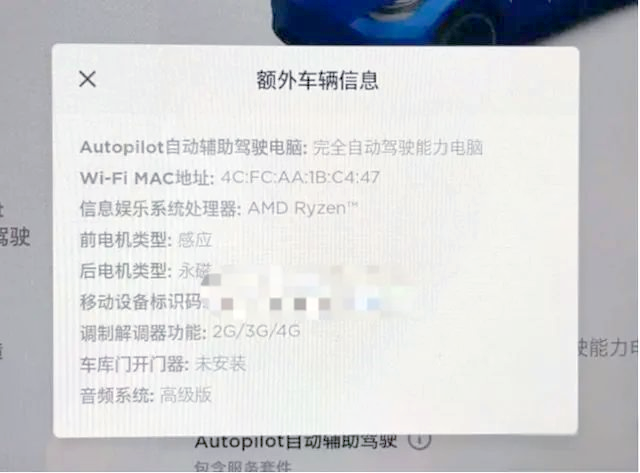 The first vehicle to adopt the AMD platform is Tesla’s Model S Plaid, which officially began deliveries in the North American market in June 2021. According to Tesla’s official website, the delivery time for Model S Plaid in China is expected by the end of 2022. Currently, the models equipped with the AMD infotainment system in the domestic market are mainly Model 3 and Y. There are rumors that the Model 3 and Y models delivered in 2022 will gradually switch to the AMD platform, although the specific timeline has yet to be determined.
The first vehicle to adopt the AMD platform is Tesla’s Model S Plaid, which officially began deliveries in the North American market in June 2021. According to Tesla’s official website, the delivery time for Model S Plaid in China is expected by the end of 2022. Currently, the models equipped with the AMD infotainment system in the domestic market are mainly Model 3 and Y. There are rumors that the Model 3 and Y models delivered in 2022 will gradually switch to the AMD platform, although the specific timeline has yet to be determined.
To gain a deeper understanding of Tesla’s MCU0, this article compiles some disassembly materials for discussion. The disassembly images of Model S Plaid mainly come from Ingineerix’s video, while the disassembly images of Model Y Performance primarily come from the “Super Workshop” video [1].
MCU0 is Tesla’s third-generation infotainment system, with its main control part upgraded to AMD’s Ryzen embedded APU and RDNA2 architecture GPU. Compared to the previous two generations of MCU, its performance has significantly improved.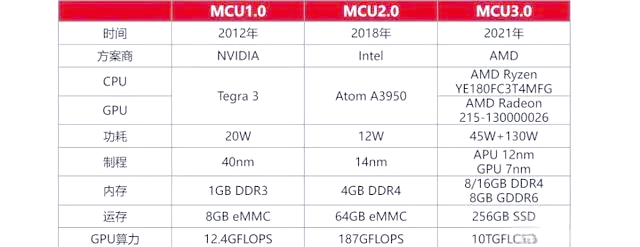 MCU0 seems to integrate a high-performance desktop workstation into the car.It is equipped with an AMD Ryzen Embedded APU and an independent graphics card based on the AMD RDNA2 architecture, featuring 8GB of GDDR6 video memory, supporting network connectivity, and equipped with Bluetooth and Wi-Fi capabilities. Additionally, it runs a Linux operating system, capable of supporting AAA-level games and external controllers for gaming operations. Notably, it also comes with a branded audio system; although it lacks a keyboard and mouse, the touchscreen operation inside the car is evidently more convenient. The horizontally oriented large touchscreen undoubtedly provides an outstanding experience for watching movies and playing games.
MCU0 seems to integrate a high-performance desktop workstation into the car.It is equipped with an AMD Ryzen Embedded APU and an independent graphics card based on the AMD RDNA2 architecture, featuring 8GB of GDDR6 video memory, supporting network connectivity, and equipped with Bluetooth and Wi-Fi capabilities. Additionally, it runs a Linux operating system, capable of supporting AAA-level games and external controllers for gaming operations. Notably, it also comes with a branded audio system; although it lacks a keyboard and mouse, the touchscreen operation inside the car is evidently more convenient. The horizontally oriented large touchscreen undoubtedly provides an outstanding experience for watching movies and playing games.
Currently, the Tesla Model S Plaid is equipped with 8GB LPDDR4 memory, 256GB SSD storage, and a 17-inch touchscreen; while the Model Y Performance features 16GB LPDDR4 memory, 256GB SSD storage, and a 15-inch touchscreen.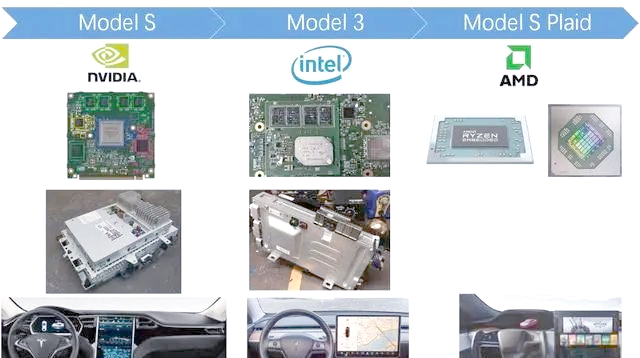 If we compare MCU0 to a high-performance desktop workstation, the previous generation MCU0 resembles a 15-inch tablet or entry-level laptop, equipped with an Intel Atom A3950 processor with a clock speed of 6GHz and 4GB DDR4 memory, making its performance appear more ordinary compared to MCU0.
If we compare MCU0 to a high-performance desktop workstation, the previous generation MCU0 resembles a 15-inch tablet or entry-level laptop, equipped with an Intel Atom A3950 processor with a clock speed of 6GHz and 4GB DDR4 memory, making its performance appear more ordinary compared to MCU0.
MCU0 brings the powerful computing power of a desktop into the car, providing a smoother control experience.Moreover, it effectively integrates a “PS5” gaming console into the vehicle, allowing owners to enjoy large-scale games like Cyberpunk 2077 and The Witcher while driving, greatly enhancing the entertainment and playability of the car. Although the gaming market is relatively niche, and the number of people playing AAA games in cars is not large, the hardware power provided by MCU0 is more than sufficient, bringing rich processing capabilities to the infotainment applications. This high-performance configuration, while possibly excessive for a niche market, offers a cool experience and extreme sensations that can bring unexpected surprises to users. Users often develop a deep affection for such unexpected experiences, which may reflect its value more than cost savings.
Although the gaming market is relatively niche, and the number of people playing AAA games in cars is not large, the hardware power provided by MCU0 is more than sufficient, bringing rich processing capabilities to the infotainment applications. This high-performance configuration, while possibly excessive for a niche market, offers a cool experience and extreme sensations that can bring unexpected surprises to users. Users often develop a deep affection for such unexpected experiences, which may reflect its value more than cost savings.
Tesla’s choice of technology route for its infotainment system is unique; it uses x86 architecture chips paired with a Linux system, contrasting sharply with the mainstream ARM architecture chips and Android systems in China. The x86 architecture excels in running large software, and Tesla’s infotainment operating system is based on a secondary development of Linux, featuring a simple system and optimized controls, particularly suitable for running high-load applications like large games. However, its shortcomings in ecosystem aspects are also evident compared to Android systems, as content like Bilibili and iQIYI in the cabin is usually presented in web form, resulting in slower loading speeds.
In contrast, the ARM architecture has significant advantages in the mobile internet ecosystem. Mainstream domestic car manufacturers typically choose to develop based on the Android system and optimize user experience through app and UI adaptations. In terms of ecosystem experience, the Android system undoubtedly excels.
Both architectures have their strengths, and the ultimate user experience will depend on the hardware performance and software optimization levels of each car manufacturer. In the PC era, the x86 architecture once dominated; while in the mobile internet era, the ARM architecture has taken the lead. So, which technology route do you favor in the future automotive application field?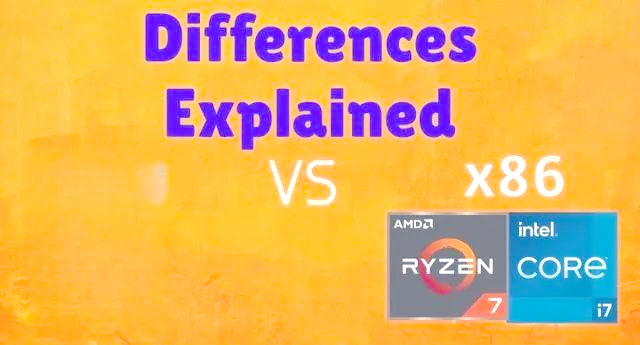 Unlike the configurations of the previous generation Model S, MCU0 has been integrated into the CCM (Central Control Module). The surface of this CCM controller is intricately engraved with module names, manufacturers, and usage precautions, and its manufacturing source is from Taiwan, showcasing Tesla’s innovation and dedication in automotive technology.
Unlike the configurations of the previous generation Model S, MCU0 has been integrated into the CCM (Central Control Module). The surface of this CCM controller is intricately engraved with module names, manufacturers, and usage precautions, and its manufacturing source is from Taiwan, showcasing Tesla’s innovation and dedication in automotive technology. Inside the new CCM central control module, four PCB boards are meticulously arranged, with an additional AMD GPU core board compared to the Model 3 configuration. These circuit boards are responsible for multimedia control, communication, graphics processing, and the Autopilot function, demonstrating Tesla’s advancements and upgrades in automotive technology.
Inside the new CCM central control module, four PCB boards are meticulously arranged, with an additional AMD GPU core board compared to the Model 3 configuration. These circuit boards are responsible for multimedia control, communication, graphics processing, and the Autopilot function, demonstrating Tesla’s advancements and upgrades in automotive technology. Tesla has indeed demonstrated exceptional capability in building its hardware platform. Through carefully designed PCB boards, different functional modules can be flexibly combined to achieve diverse configurations. For example, the communication board design of Model Y and Model S is completely identical, while the Autopilot and Model 3’s AP0 version also maintain a high degree of compatibility. This modular design approach not only reduces production complexity but also lays a solid foundation for future technological upgrades and product improvements.Next, we will delve into the significantly changed MCU0 involving two PCBA.The front layout of the large PCBA includes core components such as APU, MCU, ADSP, as well as key devices like BT & WIFI modules, display serializers, and amplifiers. This layout design not only optimizes the production process of the PCBA but also facilitates the rework of products, ensuring high efficiency and stability in production.
Tesla has indeed demonstrated exceptional capability in building its hardware platform. Through carefully designed PCB boards, different functional modules can be flexibly combined to achieve diverse configurations. For example, the communication board design of Model Y and Model S is completely identical, while the Autopilot and Model 3’s AP0 version also maintain a high degree of compatibility. This modular design approach not only reduces production complexity but also lays a solid foundation for future technological upgrades and product improvements.Next, we will delve into the significantly changed MCU0 involving two PCBA.The front layout of the large PCBA includes core components such as APU, MCU, ADSP, as well as key devices like BT & WIFI modules, display serializers, and amplifiers. This layout design not only optimizes the production process of the PCBA but also facilitates the rework of products, ensuring high efficiency and stability in production.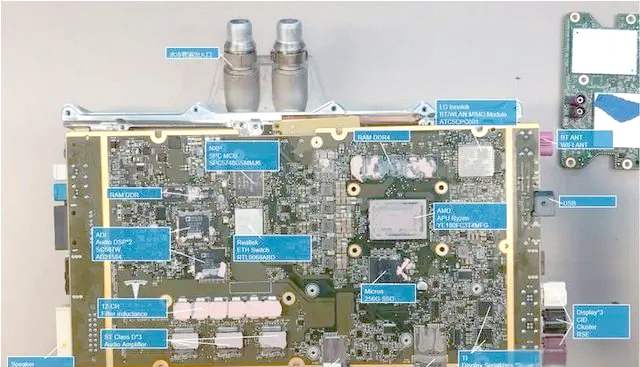 The back of the large PCBA mainly lays out passive components such as resistors and capacitors.
The back of the large PCBA mainly lays out passive components such as resistors and capacitors. The GPU motherboard is mainly equipped with the GPU chip and four independent GDDR6 memory modules, with the GPU’s OPN number (original factory number) being 215-130000026.
The GPU motherboard is mainly equipped with the GPU chip and four independent GDDR6 memory modules, with the GPU’s OPN number (original factory number) being 215-130000026.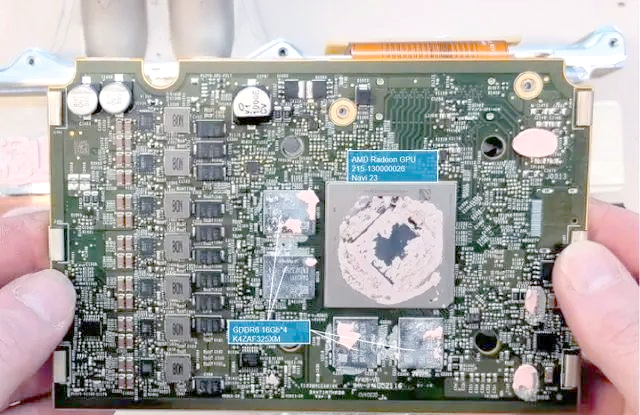
Overview of Key Components of MCU:
After discussing the configuration of the GPU motherboard, we further focus on the key components of the MCU. These components constitute the core of the MCU, affecting its performance and functionality. Next, we will list these key components in detail to provide you with a more comprehensive understanding of the MCU. When discussing the key components of the MCU, we specifically mention the choice of APU. This time, the AMD Ryzen Embedded V1000 series processor is selected, with the OPN model being “YE180FC3T4MFG”. Although we could not find this APU chip on the official website, it is likely a custom material and has passed the AEC-Q100 automotive certification. APU, or Accelerated Processing Unit, is a technology that integrates the CPU and GPU core on a single chip, achieving a high degree of fusion between the processor and GPU. This APU has a CPU base frequency of up to 3.5GHz and supports a maximum frequency of 8GHz, with 4 cores. Additionally, it integrates a Vega 11 graphics card, with a running frequency of 1300MHz, providing powerful graphics processing capabilities. Furthermore, it supports 2x10Gb Ethernet connections and a maximum of 4xHDMI0 or 4xDP4 video display capabilities, while supporting Dual Channel DDR memory, offering excellent system expandability.
When discussing the key components of the MCU, we specifically mention the choice of APU. This time, the AMD Ryzen Embedded V1000 series processor is selected, with the OPN model being “YE180FC3T4MFG”. Although we could not find this APU chip on the official website, it is likely a custom material and has passed the AEC-Q100 automotive certification. APU, or Accelerated Processing Unit, is a technology that integrates the CPU and GPU core on a single chip, achieving a high degree of fusion between the processor and GPU. This APU has a CPU base frequency of up to 3.5GHz and supports a maximum frequency of 8GHz, with 4 cores. Additionally, it integrates a Vega 11 graphics card, with a running frequency of 1300MHz, providing powerful graphics processing capabilities. Furthermore, it supports 2x10Gb Ethernet connections and a maximum of 4xHDMI0 or 4xDP4 video display capabilities, while supporting Dual Channel DDR memory, offering excellent system expandability.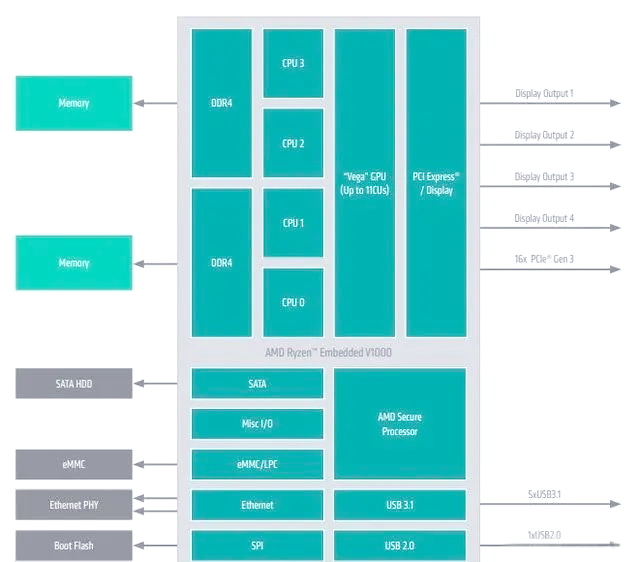 According to AMD’s official website, this APU’s single SOC design can drive the vehicle’s main unit, instrument panel, and other display devices, such as the Model S’s instrument panel, central display screen, and rear screens. Additionally, the hardware has reserved interface designs for a passenger screen, laying the foundation for the potential addition of a passenger screen function in the future. In contrast, the Model Y P may have only been equipped with a 15-inch central display screen due to cost considerations.This APU is equipped with a 256GB SSD solid-state drive and uses DDR memory, totaling 10 chips distributed on both sides, presenting two types of silk prints. Among them, 8 chips are D9XSM, while the other 2 are D9XSP. On Micron’s official website, we can find detailed models for these two types of memory, namely MT40A512M16LY-062EAAT:E and MT40A1G8SA-062EAAT:E, each with a capacity of 8Gb, or 1GB. Notably, the AAT designation indicates that these memories meet automotive grade standards, capable of stable operation within a temperature range of -40 to 105°C. Additionally, the D9XSM chips connect in x16, with 4 chips combined to form x64, totaling 8 chips on both sides, collectively forming two DIMMs (i.e., two memory sticks), providing a total memory capacity of 8GB.
According to AMD’s official website, this APU’s single SOC design can drive the vehicle’s main unit, instrument panel, and other display devices, such as the Model S’s instrument panel, central display screen, and rear screens. Additionally, the hardware has reserved interface designs for a passenger screen, laying the foundation for the potential addition of a passenger screen function in the future. In contrast, the Model Y P may have only been equipped with a 15-inch central display screen due to cost considerations.This APU is equipped with a 256GB SSD solid-state drive and uses DDR memory, totaling 10 chips distributed on both sides, presenting two types of silk prints. Among them, 8 chips are D9XSM, while the other 2 are D9XSP. On Micron’s official website, we can find detailed models for these two types of memory, namely MT40A512M16LY-062EAAT:E and MT40A1G8SA-062EAAT:E, each with a capacity of 8Gb, or 1GB. Notably, the AAT designation indicates that these memories meet automotive grade standards, capable of stable operation within a temperature range of -40 to 105°C. Additionally, the D9XSM chips connect in x16, with 4 chips combined to form x64, totaling 8 chips on both sides, collectively forming two DIMMs (i.e., two memory sticks), providing a total memory capacity of 8GB.
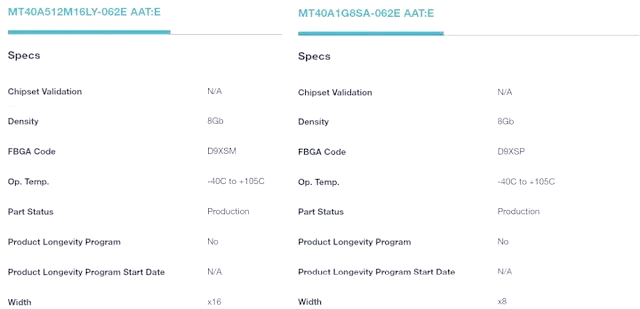 The two D9XSP chips connect in x8, and their size is noticeably smaller than the surrounding 4 chips. This design is specifically intended to achieve the ECC (Error Checking and Correcting) function of the memory, providing 8 bits of ECC width when the data width is 64 bits to enable error correction and ensure system stability. It is important to note that the ECC function is not included in the total memory capacity.
The two D9XSP chips connect in x8, and their size is noticeably smaller than the surrounding 4 chips. This design is specifically intended to achieve the ECC (Error Checking and Correcting) function of the memory, providing 8 bits of ECC width when the data width is 64 bits to enable error correction and ensure system stability. It is important to note that the ECC function is not included in the total memory capacity. The GPU section displays a diagram of the Tesla architecture, with the core being Navi23, OPN number 215-130000026. This architecture is paired with 4 independent GDDR6 memory chips from Samsung, each with a capacity of 16Gb (2GB), totaling 8GB. The transmission rate of these memory chips is 14GT/s, with a width of 128 bits. Additionally, the architecture is equipped with power supply, JTAG debugging ports, oscillators, thermal sensors, and other components. The GPU’s HDMI, DP, and PCIe structure are connected to the large board APU via a B2B (Board to Board) connector. The connector model is FX23L-100S, provided by Hirose HRS, featuring 100 pins and supporting a maximum transmission rate of 8Gbps, fully capable of meeting the high-speed data transmission requirements of HDMI/DP/PCIe Gen3.
The GPU section displays a diagram of the Tesla architecture, with the core being Navi23, OPN number 215-130000026. This architecture is paired with 4 independent GDDR6 memory chips from Samsung, each with a capacity of 16Gb (2GB), totaling 8GB. The transmission rate of these memory chips is 14GT/s, with a width of 128 bits. Additionally, the architecture is equipped with power supply, JTAG debugging ports, oscillators, thermal sensors, and other components. The GPU’s HDMI, DP, and PCIe structure are connected to the large board APU via a B2B (Board to Board) connector. The connector model is FX23L-100S, provided by Hirose HRS, featuring 100 pins and supporting a maximum transmission rate of 8Gbps, fully capable of meeting the high-speed data transmission requirements of HDMI/DP/PCIe Gen3.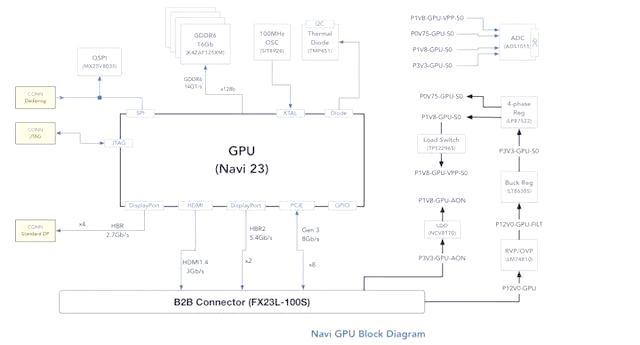 AMD’s Navi23 core independent graphics card can match the performance of the AMD Radeon PRO W6600 graphics card. This graphics card is equipped with 8GB of independent GDDR6 memory, using TSMC’s 7nm process technology, with 1792 stream processors and a peak single precision (FP32) performance of up to 4TFLOPs. Meanwhile, its thermal design power (TDP) is 130W Peak, ensuring efficient and stable performance output.
AMD’s Navi23 core independent graphics card can match the performance of the AMD Radeon PRO W6600 graphics card. This graphics card is equipped with 8GB of independent GDDR6 memory, using TSMC’s 7nm process technology, with 1792 stream processors and a peak single precision (FP32) performance of up to 4TFLOPs. Meanwhile, its thermal design power (TDP) is 130W Peak, ensuring efficient and stable performance output.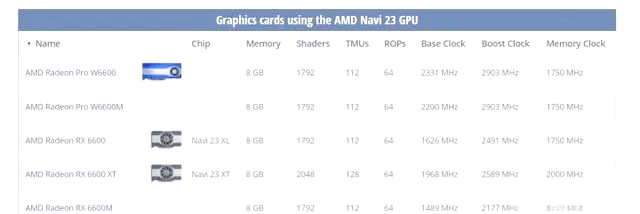 AMD’s Ryzen Embedded APU, equipped with an AMD RDNA2 architecture GPU independent graphics card, can match the computing power of current PS5 and XBOX gaming consoles.
AMD’s Ryzen Embedded APU, equipped with an AMD RDNA2 architecture GPU independent graphics card, can match the computing power of current PS5 and XBOX gaming consoles.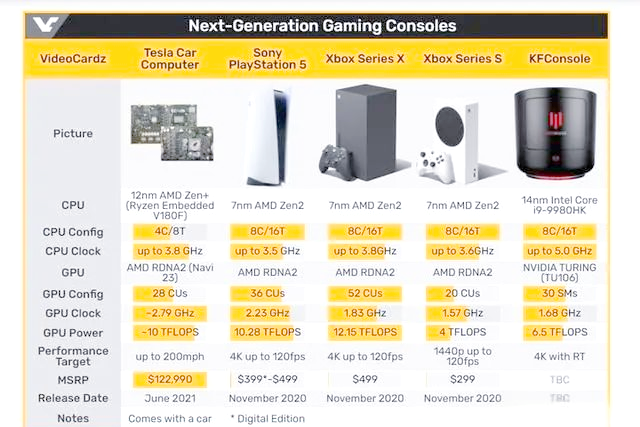 In terms of audio processing, the system uses two high-performance floating-point ADSPs, sourced from ADI’s SHARC+ series, models SC587W and AD21584. Among them, AD21584 is specifically responsible for active road noise reduction processing, while SC587W is equipped with an ARM Cortex-A5 processor and two RAMs, ensuring the efficiency and quality of audio processing.
In terms of audio processing, the system uses two high-performance floating-point ADSPs, sourced from ADI’s SHARC+ series, models SC587W and AD21584. Among them, AD21584 is specifically responsible for active road noise reduction processing, while SC587W is equipped with an ARM Cortex-A5 processor and two RAMs, ensuring the efficiency and quality of audio processing.
For amplification, the system employs three 4-channel output Class D amplifiers, with 6 sets of inductors arranged above for Class D output filtering. This design seems to support up to 12-channel output, with the official claimed audio power being 960W, equipped with 22 speakers, undoubtedly providing a brand audio-level configuration. Notably, this MCU also integrates an independent amplifier module, making the audio effect even more anticipated.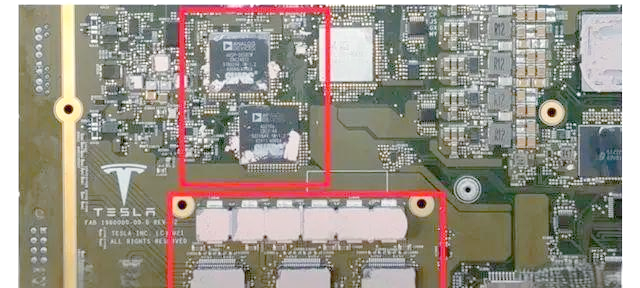 In terms of MCU, the system uses the same SPC5748GSMMJ6 model as Model 3/Y, specifically responsible for core tasks such as power control and gateway communication management. Additionally, to achieve Bluetooth and Wi-Fi connectivity, the system integrates LG Innotek’s BT and WIFI dual-module ATC5CPC001, which supports BT (v0) and 4GHz/5GHz Wi-Fi 5 (802.11a/b/g/n/ac) 2×2 MIMO Module, providing car owners with a convenient wireless connection experience.
In terms of MCU, the system uses the same SPC5748GSMMJ6 model as Model 3/Y, specifically responsible for core tasks such as power control and gateway communication management. Additionally, to achieve Bluetooth and Wi-Fi connectivity, the system integrates LG Innotek’s BT and WIFI dual-module ATC5CPC001, which supports BT (v0) and 4GHz/5GHz Wi-Fi 5 (802.11a/b/g/n/ac) 2×2 MIMO Module, providing car owners with a convenient wireless connection experience.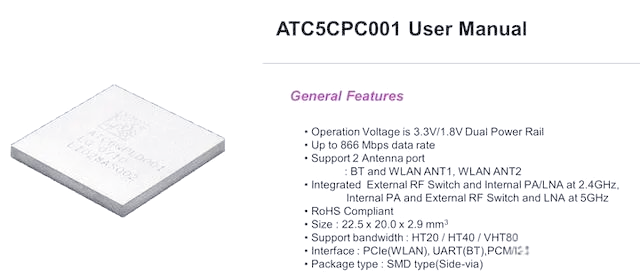 The Ethernet switch uses the Realtek RTL9068A model, which can support up to 8 ports. As for the display serializer, it is likely to have adopted TI’s solution. The inputs for GPS and cameras are integrated into the AP hardware for efficient data processing and transmission.
The Ethernet switch uses the Realtek RTL9068A model, which can support up to 8 ports. As for the display serializer, it is likely to have adopted TI’s solution. The inputs for GPS and cameras are integrated into the AP hardware for efficient data processing and transmission.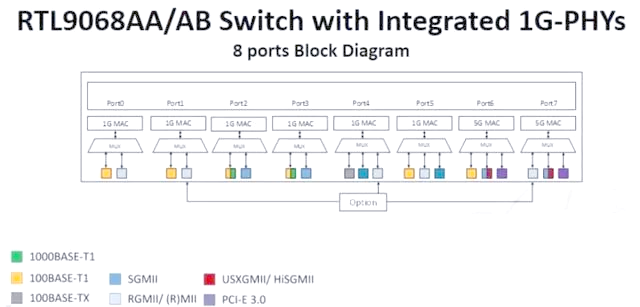 There are slight differences in the MCU between Model Y and Model S Plaid, which we will explore in detail in the next article. Additionally, here is Ingineerix’s disassembly video of the Model S Plaid central computing platform.
There are slight differences in the MCU between Model Y and Model S Plaid, which we will explore in detail in the next article. Additionally, here is Ingineerix’s disassembly video of the Model S Plaid central computing platform.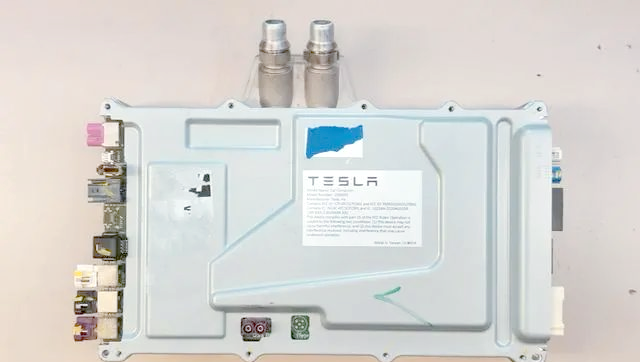
In-Depth Analysis of Tesla Model 3 Infotainment System: 3 Major Technological Breakthroughs You Absolutely Didn’t Know
In today’s smart automotive market, Tesla Model 3 continuously leads the trend with its outstanding technological innovation and user experience. With the rapid development of electrification and intelligence, this model also showcases a new intelligent infotainment system in its updates. Benefiting from Tesla’s deep accumulation in software and hardware integration, the Model 3’s infotainment system has undoubtedly become a focal point in the market. This article will delve into the technology of Tesla Model 3’s infotainment system, exploring its significance in the market and technological innovations, leading readers to understand its leading position in the smart automotive industry.
Tesla, as a pioneer in the electric vehicle industry, has an undeniable influence on the market. Since its official release in 2017, Model 3 has successfully become one of the best-selling electric vehicles globally. With the continuous enrichment of its product line and enhancement of technology, Tesla’s investment in infotainment systems is also noteworthy. According to statistics, Tesla’s annual investment in R&D has been steadily increasing, expected to exceed $1.6 billion by 2021. Such financial investment enables Model 3 to maintain its technological leadership, setting a new benchmark for the industry.
Diving into the Model 3’s infotainment system, the performance of technical parameters is particularly critical. The vehicle uses a 15-inch central touchscreen display with a resolution of 1920×1200, providing an extremely high visual experience. Additionally, the NVIDIA Drive PX 2 processor equipped in Model 3 achieves powerful computing capabilities, particularly excelling in image processing and AI intelligent learning. The infotainment system adopts a customized Linux operating system, ensuring good stability and security. In terms of camera configuration, there are a total of 8 cameras, providing 360-degree environmental perception, strongly supporting autonomous driving. According to official data, the response time of the infotainment system is only 50 milliseconds, greatly enhancing the fluidity of the user interface.
When comparing with similar electric vehicle models, Tesla Model 3 demonstrates significant advantages in technology to meet high standards of vehicle intelligence. For instance, in comparison with NIO ES6 and Xpeng P7, Tesla’s autonomous driving technology and user interaction experience of the infotainment system outperform competitors, especially in maintaining control stability, with Model 3’s performance improving by 20%. This comparison of performance metrics not only highlights its technological strength but also indicates Tesla’s competitiveness in the intelligent driving ecosystem.
The competition landscape for electric vehicles is becoming increasingly fierce in the current market. According to a report by the International Energy Agency (IEA), global electric vehicle sales are expected to reach 21 million by 2025, doubling the market share. In this broader context, Tesla undoubtedly accumulates significant advantages in lithium battery technology, intelligent driving algorithms, and continuous innovation in infotainment systems. Major smart automotive brands are increasing their investments to seize this market opportunity, and the trend of intelligence in future models will determine their market performance and consumer choices.
Industry expert David Green recently stated in a report that Tesla Model 3’s technological breakthroughs in intelligence set a new benchmark for the industry. He pointed out that as in-car intelligent systems continue to evolve, future users will increasingly rely on the intelligent services of infotainment systems. Meanwhile, Green encourages consumers to pay attention to the frequency of vehicle software updates and technological iteration progress to accurately assess the future value and market competitiveness of the model.
Looking back at the overall development trends of the industry, it is evident that Tesla Model 3 has a significant influence on both market and technology levels. Its unique design and functions in intelligent infotainment are leading a new consumer trend, attracting more and more users. At the same time, as consumers’ understanding and usage thresholds for electric vehicles decrease, Tesla’s future market prospects are worth looking forward to. Therefore, it is recommended that consumers, when choosing electric vehicles, not only focus on the hardware parameters of the vehicle but also pay attention to the user experience of the intelligent infotainment system and its applications in daily driving.
Overall, Tesla Model 3 has achieved several important breakthroughs in infotainment technology, making the integration of intelligence and electrification closer. By deeply analyzing the technical parameters, market positioning, and competitive performance of Model 3, we can expect that the smart automotive industry will continue to achieve greater development in technological innovation. We hope that readers can gain a deeper understanding through this article and welcome you to share your thoughts and experiences in the comments section.